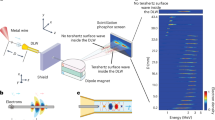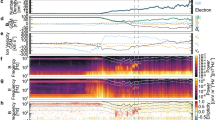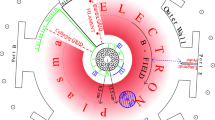Abstract
Gyrotrons are a high-power source of coherent microwave radiation1. Their oscillation mechanism is a cyclotron-resonance maser effect, in which a fraction of the rotational kinetic energy of a mildly relativistic magnetized electron beam is converted into electromagnetic energy. The most active area of gyrotron development is their potential use for heating magnetically confined fusion plasmas to the point of thermonuclear ignition. A major obstacle to this endeavour is that during high-power millimetre-wave operation2,3,4,5,6,7,8,9 competing modes and mode shifts seriously degrade a gyrotron’s stability and efficiency10,11,12,13. Here, we show that these problems can be overcome by active control of the electron-beam parameters during the oscillation. In doing so, we successfully demonstrate the robust steady-state operation of a 170 GHz gyrotron producing a continuous 1 MW output power with an unprecedented efficiency of over 55% in a hard-self-excitation region. Moreover, we find that an adjacent resonant mode previously expected to compete with and adversely affect the principal operating mode does not in fact jeopardize but rather helps this mode as a result of nonlinear effects. The result improves the outlook for using these devices for heating and instability control in future experimental fusion reactors, such as ITER14,15,16,17,18,19.
This is a preview of subscription content, access via your institution
Access options
Subscribe to this journal
Receive 12 print issues and online access
$259.00 per year
only $21.58 per issue
Buy this article
- Purchase on SpringerLink
- Instant access to full article PDF
Prices may be subject to local taxes which are calculated during checkout




Similar content being viewed by others
References
Thumm, M. High power gyro-devices for plasma heating and other applications. Int. J. Infrared Millim. Waves 26, 483–503 (2005).
Felch, K. et al. Recent ITER-relevant gyrotron tests. J. Phys. Conf. Ser. 25, 13–23 (2005).
Choi, E. et al. Megawatt power level 120 GHz gyrotrons for ITER start-up. J. Phys. Conf. Ser. 25, 1–7 (2005).
Dammertz, G. et al. High-power gyrotron development at Forschungzentrum Karlsruhe for fusion applications. IEEE Trans. Plasma Sci. 34, 173–186 (2006).
Piosczyk, B. et al. A 2 MW, 170 GHz, coaxial cavity gyrotron-experimental verification of the design of main components. J. Phys. Conf. Ser. 25, 24–32 (2005).
Agapova, M. V. et al. Proc. Joint 31th Int. Conf. on Infrared and Millimeter Waves and 14th Int. Conf. on Terahertz Electronics (Conference Digest), September 19–23, 2006, Shanghai, China 516 (IEEE, New Jersey, 2006).
Sakamoto, K. et al. Development of 170 GHz and 110 GHz gyrotrons for fusion devices. Nucl. Fusion 43, 729–737 (2003).
Sakamoto, K. et al. Development of long pulse and high power 170 GHz gyrotron. J. Phys. Conf. Ser. 25, 8–12 (2005).
Kasugai, A. et al. Long pulse operation of 170 GHz ITER gyrotron by beam current control. Fusion Eng. Des. 81, 2791–2796 (2006).
Nusinovich, G. S. Review of the theory of mode interaction in gyrodevices. IEEE Trans. Plasma Sci. 27, 313–326 (1999).
Whaley, D. R. et al. Startup methods for single-mode gyrotron operation. Phys. Rev. Lett. 75, 1304–1307 (1995).
Nusinovich, G. S. et al. Startup scenarios in high-power gyrotrons. IEEE Trans. Plasma Sci. 32, 841–851 (2004).
Nusinovich, G. S. et al. Slow processes in startup scenarios of long pulse gyrotrons. Phys. Plasmas 13, 083106 (2006).
Technical Basis for the ITER Final Design Report (FDR), 2001. http://www.iter.org.
Imai, T. et al. ITER R&D: Auxiliary Systems: Electron cyclotron heating and current drive system. Fusion Eng. Des. 55, 281–289 (2001).
Isayama, A. et al. Complete stabilization of a tearing mode in steady state high βp H-mode discharges by the first harmonic electron cyclotron heating/current drive on JT-60U. Plasma Phys. Control. Fusion 42, L37–L45 (2000).
Gantenbein, G. et al. Complete suppression of neoclassical tearing modes with current drive at the electron-cyclotron-resonance frequency in ASDEX Upgrade tokamak. Phys. Rev. Lett. 85, 1242–1245 (2000).
Luce, T. C. Development of burning plasma and advanced scenarios in the DIII-D tokamak. Nuclear Fusion 45, S86–S97 (2005).
Prater, R. Application of electron cyclotron current drive on ITER. J. Phys. Conf. Ser. 25, 257–265 (2005).
Neilson, J. Optimal synthesis of quasi-optical launchers for high power gyrotrons. Science 34, 635–641 (2006).
Minami, R. et al. The designs of high efficiency launcher of quasi-optical mode converter for high power gyrotrons. J. Infrared Millim. Waves 27, 13–24 (2006).
Sakamoto, K. et al. Major improvement of gyrotron efficiency with beam energy recovery. Phys. Rev. Lett. 73, 3532–3535 (1994).
Kisel, D. V. et al. An experimental study of gyrotron, operating at the second harmonic of the cyclotron frequency, with optimized distribution of the high-frequency field. Radio Eng. Electron Phys. 19, 95 (1974).
Dumbrajs, O. et al. Hysteresis-like effects in gyrotron oscillators. Phys. Plasmas 10, 1183 (2003).
Fliflet, A. W. et al. A self-consistent field theory for gyrotron oscillators: Application to a low Q gyromonotron. Int. J. Electron. 53, 505–522 (1982).
Fliflet, A. W. et al. Time-dependent multimode simulation of gyrotron oscillators. Phys. Rev. A 45, 6166–6176 (1991).
Maisonnier, D. et al. A conceptual study of commercial fusion power plants, EFDA(05)-27/4.10 (2005), http://www.efda.org/eu_fusion_programme/ scientific_and_technical_publications.htm (PPCS overall report final-with annexes.pdf).
Idehara, T. et al. in Conf. Digest of the 2006 Joint 31th Int. Conf. on Infrared and Millimeter Waves and 14th Int. Conf. on Terahertz Electronics, Shanghai, China (eds Shen, X. C., Lu, W., Zhang, J. & Dou, W. B.) 509 (IEEE, New Jersey, 2006).
Acknowledgements
The authors would like to thank T. Kariya, K. Hayashi and Y. Mitsunaka of Toshiba Electron Tubes and Devices for the gyrotron fabrication, and Yu. Ikeda and S. Komori of JAEA for their support of the experiment. We would like to thank T. Yamamoto, R. Yoshino, H. Takatsu and T. Tsunematsu for their encouragement.
Author information
Authors and Affiliations
Corresponding author
Ethics declarations
Competing interests
The authors declare no competing financial interests.
Supplementary information
Rights and permissions
About this article
Cite this article
Sakamoto, K., Kasugai, A., Takahashi, K. et al. Achievement of robust high-efficiency 1 MW oscillation in the hard-self-excitation region by a 170 GHz continuous-wave gyrotron. Nature Phys 3, 411–414 (2007). https://doi.org/10.1038/nphys599
Received:
Accepted:
Published:
Issue date:
DOI: https://doi.org/10.1038/nphys599
This article is cited by
-
The Progress in the Studies of Mode Interaction in Gyrotrons
Journal of Infrared, Millimeter, and Terahertz Waves (2022)
-
State-of-the-Art of High-Power Gyro-Devices and Free Electron Masers
Journal of Infrared, Millimeter, and Terahertz Waves (2020)
-
Observation of a comb-shaped filamentary plasma array under subcritical condition in 303-GHz millimetre-wave air discharge
Scientific Reports (2019)
-
Broadband terahertz-power extracting by using electron cyclotron maser
Scientific Reports (2017)
-
Design of a Millimeter-Wave Concentrator for Beam Reception in High-Power Wireless Power Transfer
Journal of Infrared, Millimeter, and Terahertz Waves (2017)



